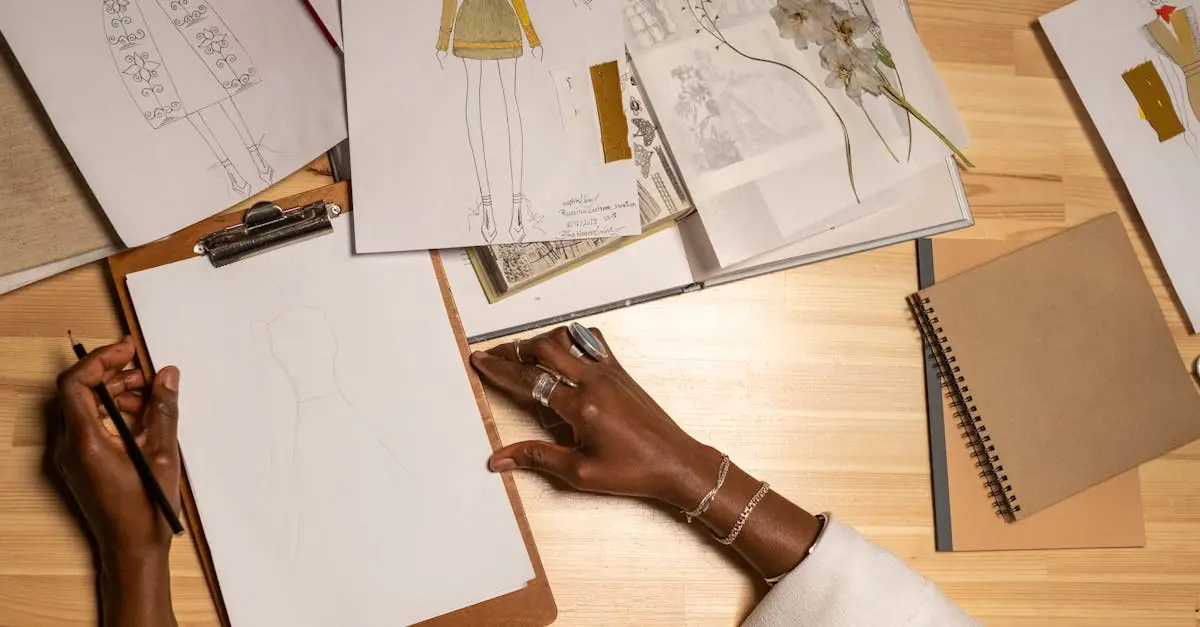Design concepts are the magic beans of the creative world. They transform vague ideas into stunning visuals that can make or break a project. Whether it’s a sleek website or a trendy logo, understanding design concepts is like having a secret recipe for success.
Table of Contents
ToggleUnderstanding Design Concepts
Design concepts serve as foundational elements in the creative process, translating abstract ideas into visually appealing forms. Grasping these concepts enhances the effectiveness of visual communication.
Definition of Design Concepts
Design concepts refer to the guiding principles that inform a designer’s creative decisions. These principles include balance, contrast, emphasis, movement, pattern, rhythm, and unity. Each concept plays a crucial role in shaping the overall aesthetic and functionality of a design. Designers employ these concepts to navigate and organize visual elements, ensuring coherence and clarity in their work. Understanding design concepts enables effective collaboration and helps maintain a consistent visual language across different projects.
Importance of Design Concepts
Design concepts significantly impact the success of visual projects. They provide structure and direction, enhancing the effectiveness of communication through design. Effective use of these concepts leads to designs that are not only visually appealing but also functional and user-friendly. A strong foundation in design concepts fosters creativity and innovation, allowing designers to explore new ideas while adhering to proven principles. Ultimately, mastering these concepts helps elevate a designer’s work, making it resonate more with audiences.
Types of Design Concepts
Design concepts encompass a variety of categories, each playing a critical role in shaping effective visuals. Understanding these types enhances a designer’s ability to create impactful work.
Visual Design Concepts
Visual design concepts focus on aesthetics and engage viewers through compelling imagery. Balance ensures elements are distributed evenly, creating a stable composition. Contrast highlights differences between elements, drawing attention effectively. Emphasis directs focus to key components, guiding the viewer’s gaze purposefully. Pattern and rhythm establish a sense of consistency, making designs familiar yet dynamic. Unity ties together all visual aspects, fostering a cohesive look throughout a project. Strong execution of these concepts elevates visual communication.
Functional Design Concepts
Functional design concepts prioritize usability to enhance the user experience. Clarity ensures that information is easily understood, reducing confusion and promoting efficiency. Hierarchy organizes content, presenting information in a logical order. Accessibility accommodates all users, ensuring designs meet diverse needs. Intuitive navigation simplifies interactions, allowing users to explore without frustration. This functionality increases user satisfaction and enhances engagement.
User-Centered Design Concepts
User-centered design concepts focus on the end user’s needs and preferences. Empathy allows designers to connect with users, understanding their perspectives and motivations. Feedback mechanisms enable continuous improvement by incorporating user input throughout the design process. Prototyping facilitates testing of ideas, validating concepts before final implementation. This iterative process ensures that designs align closely with user expectations, ultimately driving success and satisfaction.
Applying Design Concepts
Applying design concepts involves integrating the foundational elements into various phases of the creative process. Designers utilize these principles to guide their decisions, ensuring coherence and visual appeal across projects.
The Design Process
The design process consists of several stages that benefit from a solid understanding of design concepts. Exploration and research come first, where designers gather inspiration and assess user needs. Next, they generate ideas through sketching and prototyping, applying visual design concepts like balance and rhythm to create compelling visuals. Evaluation follows, allowing designers to receive feedback and refine their work based on functional design principles ensuring usability and accessibility. Finalization and delivery seal the project, driving the implementation of user-centered design concepts to align with user expectations.
Common Challenges in Implementation
Designers face several challenges in implementing design concepts effectively. Navigating conflicting priorities often poses difficulties, especially when balancing aesthetics with functionality. Time constraints frequently create pressure, leading to rushed designs that overlook essential principles like clarity and hierarchy. Additionally, gathering accurate feedback from users can present obstacles, as misunderstandings about needs may arise. Evaluating design effectiveness against predetermined goals becomes crucial to overcoming these hurdles. Continual learning and adaptation is vital for enhancing design application skills and responding to changing project demands.
Examples of Design Concepts
Design concepts find application across diverse fields, influencing the way ideas become tangible. Various examples showcase their significance in creating visually appealing and functional products.
Case Studies in Various Industries
In the fashion industry, companies like Nike demonstrate effective use of design concepts by blending visual appeal and functionality. Their cohesive branding emphasizes unity through recognizable logos and color schemes, enhancing customer recognition. The automotive sector offers a compelling example with Tesla, where user-centered concepts prioritize intuitive interfaces and seamless navigation in vehicles. In the technology field, Apple’s focus on minimalist design reflects balance and emphasis, creating an engaging user experience. Each instance illustrates how design concepts can significantly shape products and brand identity, resonating with target audiences.
Innovative Design Concept Examples
Innovative design concepts often lead to groundbreaking solutions. The concept of sustainable design continually reshapes industries by prioritizing eco-friendly materials and processes. In graphic design, the use of negative space promotes contrast and emphasizes key elements, captivating viewers. Virtual reality employs user-centered design to create immersive experiences, enhancing interactivity and engagement. Wearable technology integrates intuitive functionality with aesthetic appeal, merging distinct design principles to attract users. These examples reflect the evolving nature of design concepts, illustrating their power to transform industries and drive creativity.
Mastering design concepts is crucial for anyone in the creative field. These principles not only enhance visual appeal but also ensure functionality and user satisfaction. By understanding and applying visual, functional, and user-centered design concepts, designers can create work that resonates with audiences while meeting project goals. The ability to adapt and innovate using these concepts can significantly elevate a designer’s impact in various industries. As the landscape of design continues to evolve, staying informed about these foundational elements will empower designers to push boundaries and deliver exceptional results.



